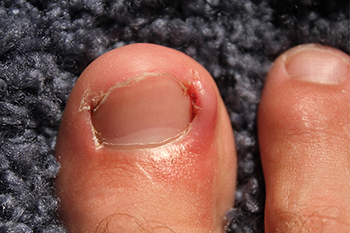Surgery for Ingrown Toenails
Tuesday, 12 December 2023 00:00
Ingrown toenails can be a persistent source of discomfort, often caused by improper toenail care or wearing ill-fitting shoes. When conservative measures fail, surgical intervention becomes a viable solution to address the root cause and provide lasting relief. The primary goal of ingrown toenail surgery is to eliminate infection and pain. Before considering surgery, it is beneficial to implement conservative measures. These can include cutting toenails straight across and avoiding leaving sharp edges, and opting for shoes that accommodate the natural position of the toes. In some cases, a podiatrist may be able to manually address the issue by pushing the skin away from the ingrown toenail or carefully trimming the offending toenail section. Surgical procedures for ingrown toenails include nail avulsion, involving the complete removal of the toenail and wedge excision. This procedure removes the section of the toenail growing into the skin, along with the adjacent tissue. Another surgical remedy is nail-bed ablation, partial or complete toenail removal. This is followed by the application of a chemical to the tissue where the toenail originates. Electrocautery methods may also be employed. If you experience ingrown toenails on a regular basis, it is suggested that you schedule an appointment with a podiatrist for a full examination and suggested treatment options.
Ingrown toenails can become painful if they are not treated properly. For more information about ingrown toenails, contact one of our podiatrists of Ankle & Foot Care Center. Our doctors can provide the care you need to keep you pain-free and on your feet.
Ingrown Toenails
Ingrown toenails occur when a toenail grows sideways into the bed of the nail, causing pain, swelling, and possibly infection.
Causes
- Bacterial infections
- Improper nail cutting such as cutting it too short or not straight across
- Trauma to the toe, such as stubbing, which causes the nail to grow back irregularly
- Ill-fitting shoes that bunch the toes too close together
- Genetic predisposition
Prevention
Because ingrown toenails are not something found outside of shoe-wearing cultures, going barefoot as often as possible will decrease the likeliness of developing ingrown toenails. Wearing proper fitting shoes and using proper cutting techniques will also help decrease your risk of developing ingrown toenails.
Treatment
Ingrown toenails are a very treatable foot condition. In minor cases, soaking the affected area in salt or antibacterial soaps will not only help with the ingrown nail itself, but also help prevent any infections from occurring. In more severe cases, surgery is an option. In either case, speaking to your podiatrist about this condition will help you get a better understanding of specific treatment options that are right for you.
If you have any questions please feel free to contact our office located in Jupiter, FL . We offer the newest diagnostic and treatment technologies for all your foot and ankle needs.



